RIC-3531 Primary Science - Book D (Digital)
You also want an ePaper? Increase the reach of your titles
YUMPU automatically turns print PDFs into web optimized ePapers that Google loves.
Gyrocopter<br />
Flight – Activity 2<br />
Lesson Focus<br />
Outcomes<br />
Energy and Change<br />
2.5 Describes properties of<br />
light, sound, heating and<br />
movement.<br />
Indicators<br />
• Constructs a flying<br />
machine.<br />
• Makes a variety of<br />
alterations to improve the<br />
performance of a flying<br />
machine.<br />
Skills Focus<br />
• Follows a procedure<br />
• Predicts<br />
• Conducts simple tests<br />
• Observes<br />
• Identifies patterns<br />
• Draw conclusions<br />
• Collects data<br />
Background Information<br />
An autogyro is like a helicopter<br />
in that it generates the lift<br />
needed to fly by using rotors<br />
(rotating wings) on top rather<br />
than stationary wings. Unlike<br />
the helicopter, the rotors are<br />
not powered and need a flow<br />
of air over their surfaces to<br />
keep them moving.<br />
When the model gyrocopter<br />
falls, air pushes up against<br />
the blades, bending them up<br />
slightly. The two blades get<br />
the same amount of push<br />
but in opposite directions,<br />
causing the gyrocopter to spin.<br />
Changing the blade directions<br />
will cause it to spin in different<br />
directions.<br />
Adding a weight (e.g. a<br />
paperclip) to the base will<br />
make it spin faster to the<br />
ground.<br />
Igor Sikorsky designed the first<br />
successful helicopter in the<br />
late 1930’s. He was inspired by<br />
Leonardo da Vinci’s drawings<br />
of an aircraft with a rotating,<br />
screw-like rotor.<br />
Before the Lesson<br />
Materials Needed<br />
Gyrocopter pattern, scissors, paperclips.<br />
Preparation<br />
• Collect pictures or videos of planes with propellers, helicopters or ‘rotor’ designs<br />
through the ages.<br />
• Make a model gyrocopter and practise from a variety of positions, using different<br />
weights. These may help the performance of the craft when dropped from a<br />
higher position, such as when standing on a chair or desk.<br />
The Lesson<br />
Stimulus<br />
Show pictures or videos of helicopters, autogyros, and if possible da Vinci’s<br />
drawings or early rotor models. Discuss their use of rotor blades for flight. Explain<br />
how the students will make a rotor-like flying machine.<br />
What to Do<br />
• Ask the students to cut out the gyrocopter pattern. Cut along the solid lines only.<br />
Fold on the dotted lines.<br />
• Fold ‘A’ wing towards you and ‘B’ wing away from you.<br />
• Fold ‘C’ and ‘D’ so they overlap each other.<br />
• Fold the base ‘E’ upwards along the dotted line.<br />
• Experiment with the gyrocopter to see how it flies. What do you notice? What<br />
direction does it spin, clockwise or anticlockwise? Can you make it change<br />
directions? Colour it brightly and watch the colours as it spins.<br />
• Experiment further with the design. Record the changes and how each affects its<br />
flight. (For example, add weight (paperclips), alter blade angles, lengthen blades,<br />
alter the width, drop it from different heights, throw it upwards and let it drop.)<br />
• The students alter two different variables and test and record the differences in<br />
performance.<br />
• Which design was better? Explain why.<br />
• Have students discuss their changes and designs with the class.<br />
After the Lesson<br />
Answers<br />
Teacher check<br />
Additional Activities<br />
• Have students experiment and select their best gyrocopter design. Hold<br />
competitions to time the fastest/slowest ‘copter’.<br />
• Make a large gyrocopter (as big as you can) and a tiny version. Experiment and<br />
compare the two. Does size alter the performance?<br />
• Write a report about Igor Sikorsky and his first helicopter design.<br />
Display Ideas<br />
©R.I.C. Publications<br />
Low Resolution Images<br />
Display Copy<br />
• Make a time line with pictures about helicopter<br />
or ‘rotor’ designs through the ages. Display<br />
around the classroom.<br />
• Investigate jobs where helicopters are used<br />
(news – traffic reports, firefighting, defence<br />
forces, rescue, farming etc.). Display pictures,<br />
drawings and information about how the<br />
machines are important for each job.<br />
Safety Warning<br />
Do not aim flying objects at<br />
any person.<br />
Always test flying objects in<br />
safe conditions and areas.<br />
Fly them away from people<br />
or windy conditions.<br />
74 PRIMARY SCIENCE ~ R.I.C. Publications ® ~ www.ricpublications.com.au<br />
ISBN 978-1-925660-54-8

















